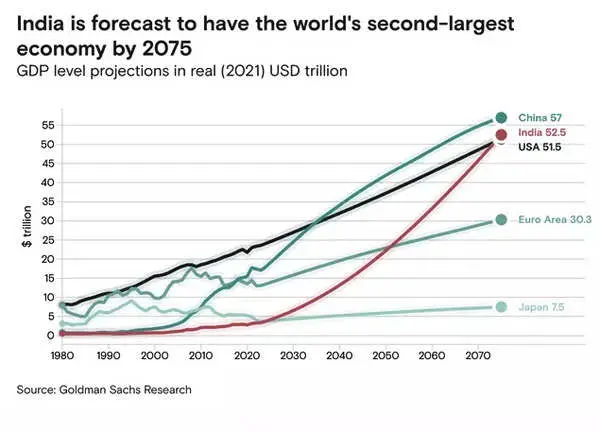Table of content
India is expected to benefit at China’s expense, according to predictions by Goldman Sachs :
India has also helped shape a new dawn of multilateralism, allowing developing countries to take their rightful place in global discourse. Goldman Sachs predicts India’s GDP growth will reach 6.4% in 2024, outpacing China’s growth of 5.4% and 4.6%.The Organization for Economic Cooperation and Development (OECD) projects India’s growth at 6.3% in 2023 and 6.1% in 2024, ahead of China’s growth rates.
India’s actions could lead to becoming the world’s third-largest economy within five years and a developed nation by 2047, setting an example for inclusive, sustainable economic growth, digital development, and climate action. They foresee India’s growth surpassing 6%.India has become a significant economic and geopolitical power, taking the presidency of the G20 in 2023. Its emphasis on rule-based international order, collaboration, and democratic values positions it as a stabilizing force in a complex global geopolitical landscape.
Video Source : Business today
Overall, Goldman Sachs predicts that India will outperform China in terms of economic growth, with a projected growth rate exceeding 6%. This optimistic outlook is based on India’s demographic advantage, economic reforms, increased foreign investment, robust digital infrastructure, and expanding consumer market.
What are the reasons behind India’s growth?
- India’s Economic Growth Story• Demographics: Large, youthful population contributes to economic growth.
• Services Sector: IT, BPO, and financial services drive the economy.
• Reforms and Liberalization: Economic reforms in the 1990s opened markets and facilitated FDI.
• Infrastructure Development: Investments in infrastructure enhance productivity and connectivity.
• Manufacturing and Make in India: “Make in India” campaign boosts domestic manufacturing.
• Digital Revolution: Digital transformation expands access to technology and e-commerce.
• Entrepreneurship and Innovation: Vibrant startup ecosystem fosters innovation.
• Agriculture and Rural Economy: Policies support rural development and income generation.
• Global Trade and Investment: Active engagement in global trade and investment partnerships.
• Resilience and Adaptability: India’s resilience and adaptability contribute to sustained growth.
How does Make in India work?
Make in India is a government initiative launched on September 25, 2014, aimed at promoting domestic manufacturing and attracting both local and foreign investments. The initiative focuses on various sectors, such as automobiles, electronics, textiles, and defense, and encourages companies to establish manufacturing units, research centers, and innovation hubs.
The government facilitates investments through policy reforms, ease of doing business, and infrastructure development. Companies investing in manufacturing facilities in India receive incentives, tax benefits, and other support.
The initiative also emphasizes skill development and training to create a skilled workforce capable of contributing to the manufacturing sector. The initiative promotes India as a global manufacturing hub, actively engaging with international investors, businesses, and governments to showcase India’s potential. It aligns with the “Vocal for Local” campaign, emphasizing the use of domestically produced goods and supporting local industries.
In summary, Make in India aims to transform India into a manufacturing powerhouse, boost economic growth, create jobs, and enhance India’s position in the global supply chain.
What are the challenges faced by Make in India?
India’s Make in India initiative, launched in 2014, aims to transform the country into a global design and manufacturing hub. However, India faces several challenges, including inadequate infrastructure, a shortage of skilled labor, high capital costs, complex tax and labor laws, bureaucratic delays, barriers to innovation, corruption and transparency, strengthening small and medium-sized enterprises (SMEs), global competition, and skill development.
Insufficient roads, ports, and reliable power supply impact efficiency and logistics, while the high cost of capital can deter investments. Streamlining administrative procedures is essential to streamline processes and encourage innovation.
Addressing these challenges will enhance the effectiveness of the Make in India initiative and contribute to India’s economic growth and global standing. By bridging the skills gap through vocational training and education, India can continue to drive productivity and innovation in the global manufacturing sector.
The government is actively working to tackle these issues.
The Indian Government’s Strategy for Economic Growth and Manufacturing
• Infrastructure Development: To enhance port infrastructure and road connections, programs like Bharatmala and Sagarmala were started.
• Skill Development: Well-established apprenticeship programs and vocational training facilities.
Simplified processes for launching and running enterprises contribute to the ease of doing business.
• Tax Reforms: To simplify taxes, the Goods and Services Tax (GST) was introduced.
• Made in India 2.0: Introduced to draw capital and increase production in ten important industries.
• Investment Promotion: Promoted India as an investment destination by helping investors through Invest India.
• Research and Innovation: Technology parks and established R&D centers.
Worked on labor law reforms to strike a balance between company ease of doing business and worker rights.
• International commerce Agreements: India’s international commerce is improved via bilateral and multilateral trade agreements.
For More Article Click Here
